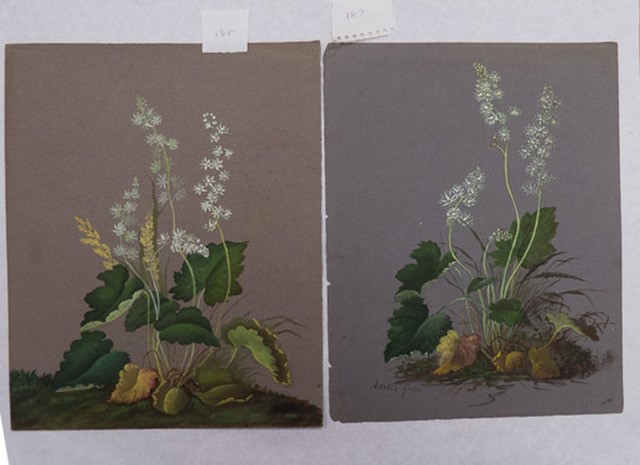It was, most likely, a foggy day in Oakland in 1882 when Miss Adelia Gates crossed the intersection of 12th and Washington streets and approached the Lemmon Herbarium.
At 57, Adelia Gates was an accomplished artist and well-accustomed to new situations. She’d traveled alone to Scandinavia, Mallorca, Italy, and Algeria, and she’d lived in Switzerland while studying watercolor with Emilie Vouga. Now, curiosity drove her to learn the science behind her flower paintings—and who better to learn from than Sara and John Lemmon? After all, they were renowned Western botanists, and Sara’s scientific illustrations were so admired that she was the first woman allowed to speak to the august California Academy of Science.

Standing there on the Lemmons’ front porch, Gates had an offer in mind, a trade. Soon after that meeting, Sara Lemmon wrote her sister on February 1, 1882, about how she was, as usual, much too busy. She added, “I have also started taking lessons in watercolors of a Miss Gates … [who] said that if we would exchange and give her lessons in botany she would be glad to assist me all she could in flower painting and sketch from nature. … Already it is beginning to tell in [John’s] and my lectures. I get more freedom with colored chalk on the boards as illustrations before the classes.”
* * *
Four years ago, I began researching Sara Plummer Lemmon for an eventual book. I believe she’s another “hidden figure” of science, another woman whose husband was credited for much of her own rigorous work. Thanks to the archivists at the University and Jepson Herbaria in Berkeley, California, I’ve been able to photograph and study Sara’s hand-written letters along with her exquisite but oh-so-fragile watercolors.
While examining the paintings, I realized about a dozen of them were signed “Adelia Gates.”

Hmm, I wondered, So, who’s Adelia Gates?
A web search led me to a 2011 post by Nora Lockshin, Senior Paper Conservator at the Smithsonian Institution Archives. She described Adelia Gates and her technique of using darker papers to illustrate light-colored plants more dimensionally, learned from Emilie Vouga—and the very same technique I was seeing in Sara’s work.
I fired off an email message, thinking, After six years, this inquiry will no doubt go nowhere, but it’s worth a shot – and almost instantly I received an answer from Nora!
That first message has led to a lively conversation: The Smithsonian’s collection includes more than 325 of Adelia’s paintings—and I have photographs of at least 15 more that are housed at Berkeley. Not only that, but I have copies of Sara’s letters describing the Lemmons’ friendship with Gates and some of what Sara learned from her. Below are two paintings, one signed by Gates and the other labeled on the back in Sara Lemmon’s handwriting as “After Adelia Gates”—quite possibly Lemmon’s homework assignment?

Sadly, according to Sara’s notes, it seems Gates went blind and spent her last eight years in an “Old People’s Home.” She apparently ran out of money sometime after the 1906 San Francisco earthquake; according to notes on the back of several paintings, Sara organized a benefit, selling many of Gates’ watercolors to raise funds, and then buying what was left herself to give the money to her friend.
What’s next for this adventure in art history? A conversation between the Smithsonian Institution Archives, the UC and Jepson Archives, and the conservator who assessed the Berkeley paintings, an opportunity to conserve more of both Sara’s and Adelia’s work?
Who knows…
If a “vintage” Archives blog post could re-kindle Sara and Adelia’s collaboration — 136 years later — anything is possible!
Related Resources
- “Adelia Gates—Flower Painter or Botanical Illustrator?”, The Bigger Picture Blog
- Emilie Vouga—(entry) Benezit Dictionary of Artists, Oxford Art Online
- John and Sara (Plummer) Lemmon papers, 1863-1911—University and Jepson Herbaria Archives, University of California, Berkeley.
- Adelia Gates Collection, 1879-1898 and undated, Record Unit 7312, Smithsonian Institution Archives
Produced by the Smithsonian Institution Archives. For copyright questions, please see the Terms of Use.

Leave a Comment